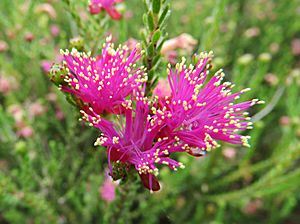Eremaea fimbriata facts for kids
Quick facts for kids Eremaea fimbriata |
|
|---|---|
 |
|
| Eremaea fimbriata in the Royal Botanic Gardens, Cranbourne | |
| Scientific classification | |
| Genus: |
Eremaea (plant)
|
| Species: |
fimbriata
|
| Synonyms | |
|
Melaleuca curtifolia Craven & R.D.Edwards |
|
Eremaea fimbriata is a cool plant that belongs to the myrtle family, called Myrtaceae. You can only find it growing naturally in the south-west part of Western Australia. It's a small bush with tiny leaves and pretty purple flowers that grow one by one at the tips of its branches. When the flowers are gone, they leave behind woody, urn-shaped fruits with a small hole at the top. What's special about Eremaea fimbriata is that it starts growing new parts in July or August, unlike other plants in its group that sleep through winter.
Contents
What Eremaea fimbriata Looks Like
Eremaea fimbriata is a shrub, which is a type of bush. It usually grows to be about 1.0 metre (3 ft) tall.
Leaves
The leaves of this plant are shaped like a narrow egg. They get thinner towards the end, forming a point. Each leaf is about 4–8 millimetres (0.2–0.3 in) long and 0.5–4 millimetres (0.020–0.16 in) wide. If you look closely at the bottom of the leaf, you might see one or sometimes three veins. The top of the leaves has a few long, soft hairs. The bottom side is covered with many short, fine hairs.
Flowers and Fruits
The flowers of Eremaea fimbriata are pink to a deep pink color. They grow by themselves at the ends of long branches that grew the year before. Each flower is about 10–20 millimetres (0.4–0.8 in) across.
Flower Parts
The flowers have five sepals. Sepals are like small leaves that protect the flower bud. These sepals are very hairy on the outside and have a small tuft of hairs at the top. There are also five petals, which are the colorful parts of the flower. These petals are about 2.8–4.6 millimetres (0.1–0.2 in) long.
Inside the flower, you'll find the stamens. Stamens are the parts that make pollen. They are about 8 millimetres (0.3 in) long and are grouped into five bundles. Each bundle has about 13 to 18 stamens.
Flowering Time and Fruits
Eremaea fimbriata flowers from July to September. After the flowers bloom, they turn into woody capsules. These capsules are like small seed pods. They are about 8.6–11 millimetres (0.3–0.4 in) long, smooth, and shaped like an urn or almost like a ball, with a small opening at the top.
How it Got its Name
The plant Eremaea fimbriata was first officially described in 1839. This was done by a person named John Lindley in his book, A Sketch of the Vegetation of the Swan River Colony. The second part of its name, fimbriata, comes from a Latin word. Fimbriatus means "fringed," which probably describes some part of the plant's appearance.
Where Eremaea fimbriata Lives
You can find Eremaea fimbriata in areas close to the coast in Western Australia. It grows in sandy soils, which often have a type of gravel called lateritic gravel mixed in. It's found in specific regions like the Geraldton Sandplains, Jarrah Forest, and Swan Coastal Plain.
Is it Protected?
The Western Australian Government Department of Parks and Wildlife has looked at Eremaea fimbriata. They have decided that it is "not threatened," which means it's not currently in danger of disappearing.

